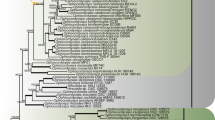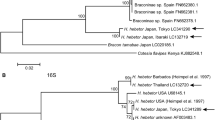Abstract
To investigate the host specificity of Ophiocordyceps nutans against hemipteran insects in the wild, we determined the relationship between host species and rDNA-internal transcribed spacer (ITS) variation in O. nutans. The analyzed fungal specimens infected 16 host species belonging to four families of Hemiptera. The molecular phylogenetic analysis revealed that O. nutans can be classified into two types corresponding to their host families. The genetic distance values between the two types were very remote (>0.084), and the strains of O. nutans that parasitized Halyomorpha halys and Plautia crossota stali, well-known insect pests, formed a subclade. The results suggest that O. nutans should have host specificity which can be valuable for developing biological control agents against specific hemipteran insects.


Similar content being viewed by others
References
Chen YQ, Wang N, Qu LK, Li TH, Zhang WM (2001) Determination of anamorph of Cordyceps sinensis inferred from the analysis of the ribosomal transcribed spacers and 5.8S rDNA. Biochem Syst Ecol 29:597–607
Chen YQ, Hu B, Xu F, Zhang W, Zhou H, Qu LH (2004) Genetic variation of Cordyceps sinensis, a fruit-body-producing entomopathogenic species from different geographical regions in China. FEMS Microbiol Lett 230:153–158
Chou WN, Chang TT (2005) Mushrooms of Taiwan (in Chinese). Yuan-Liou Publishing, Taipei
Esaki T (1929) On Cordyceps nutans Patouillard from the province of Chikugo (in Japanese). Kyushu Teikoku Daigaku Nougakubu Gakugeizasshi 3:221–231
Evans HC, Smith SM, Katundu JM, Kapama JT (1999) A Cordyceps pathogen of sugar-cane white grubs in Tanzania. Mycologist 13:11–14
Fukatsu T (1999) Entomoparasitic fungi related to Cordyceps and endosymbiotic fungi of insects: insights into the origin and evolution of endosymbiosis (in Japanese). Trans Mycol Soc Jpn 40:34–41
Fukuhara T (1989) Insect pathology (in Japanese). Gakkai Shuppan Center, Tokyo
Gardes M, Bruns TD (1993) ITS primers with enhanced specificity for basidiomycetes: application to the identification of mycorrhizae and rusts. Mol Ecol 2:113–118
Hywel-Jones N (1995) Notes on Cordyceps nutans and its anamorph, a pathogen of hemipteran bugs in Thailand. Mycol Res 99:724–726
Ito Y, Hirano T (1997) The determination of the partial 18 S ribosomal DNA sequences of Cordyceps species. Lett Appl Microbiol 25:239–242
Jensen AB, Thomsen L, Eilenberg J (2001) Intraspecific variation and host specificity of Entomophthora muscae sensu stricto isolates revealed by random amplified polymorphic DNA, universal primed PCR, PCR-restriction fragment length polymorphism, and conidial morphology. J Invertebr Pathol 78:251–259
Kimura M (1980) A simple method for estimating evolutionary late of base substitutions through comparative studies of nucleotide sequence. J Mol Evol 16:111–120
Li HM, Deng RQ, Wang XZ (2006) Phylogenetic relationships of the Pentatomomorpha (Hemiptera: Heteroptera) inferred from nuclear 18S rDNA sequences. Zool Res 27:307–316
Moureau J (1949) Cordyceps of the Belgian Congo (in French). Mem Inst R Colon Belg Sect Sci Nat Med 7:1–58
Nikoh N, Fukatsu T (2000) Interkingdom host-jumping underground: phylogenetic analysis of entomoparasitic fungi of the genus Cordyceps. Mol Biol Evol 17:629–638
Patouillard NT (1887) Mushrooms outside Europe (in French). Bull Soc Mycol Fr 3:119–131
Saitou N, Nei M (1987) The neighbor-jointing method: a new method for reconstructing phylogenetic trees. Mol Biol Evol 4:406–425
Samson RA, Evans HC (1975) Notes on entomogenous fungi from Ghana. 3. The genus Hymenostilbe. Proc K Ned Akad Wet Ser C 78:73–80
Sasaki F, Miyamoto T, Tamai Y, Yajima T (2004) Isolation of vegetable wasps and plant worms, Cordyceps nutans, from fruit-body tissue. J Invertebr Pathol 85:70–73
Sasaki F, Miyamoto T, Tamai Y, Yajima T (2005) Optimum temperature and pH for mycelial growth of Cordyceps nutans Pat. (Ascomycetes). Int J Med Mushrooms 7:301–304
Sasaki F, Miyamoto T, Yamamoto A, Tamai Y, Yajima T (2008) Morphological and genetic characteristics of the entomopathogenic fungus Ophiocordyceps nutans and its host insects. Mycol Res 112:1241–1244
Sato H, Kamata N, Shimazu M (1997) Aerial infection of Cordyceps militaris link (Clavicipitales: Clavicipitaceae) against larvae of Quadricalcarifella punctatella (Motschulsky) (Lepidoptera: Notodontidae). Appl Entomol Zool 32:249–252
Shimizu D (1994) Color iconography of vegetable wasps and plant worms (in Japanese). Seibundo Shinkosha, Tokyo
Sung JM (1996) The insects-born fungus of Korea in color (in Korean). Kyo-Hak Publishing, Seoul
Sung JM, Kim CH, Yang KJ, Lee HK, Kim YS (1993) Studies on the distribution and utilization of Cordyceps militaris and C. nutans (in Korean). Korean J Mycol 21:94–105
Tamura K, Dudley J, Nei M, Kumar S (2007) MEGA4: molecular evolutionary genetic analysis (MEGA) software version 4.0. Mol Biol Evol 24:1596–1599
Thompson JD, Higgins DG, Gibson TJ (1994) CLUSTALW: improving the sensitivity of progressive multiple sequence alignment through sequence weighting, position specific gap penalties and weight matrix choice. Nucleic Acids Res 22:4673–4680
Tian LH, Hu B, Zhou H, Zhang WM, Qu LH, Chen YQ (2010) Molecular phylogeny of the entomopathogenic fungi of the genus Cordyceps (Ascomycota: Clavicipitaceae) and its evolutionary implications. J Syst Evol 48:435–444
Tomokuni M, Yasunaga T, Takai M, Yamashita I, Kawamura M, Kawasawa T (1993) A field guide to Japanese bugs (in Japanese). Zenkoku Noson Kyoiku Kyokai, Tokyo
Tsuda K, Yoshioka T, Tsutsumi T, Yamanaka M, Kawarabata T (1997) Pathogeny of Beauveria bassiana isolates obtained from stink bugs to brown-winged green bug, Plautia stali (Hemiptera: Pentatomidae) (in Japanese). Jpn J Appl Entomol Zool 41:95
Tsutsumi T (2003) Stinkbugs attacking fruits: their interesting ecology and control (in Japanese). Nobunkyo, Tokyo
Wada S, Horita M, Hirayae K, Shimazu M (2003) Discrimination of Japanese isolates of Beauveria brongniartii (Deuteromycota: Hyphomycetes) by RFLP of the rDNA-ITS regions. Appl Entomol Zool 38:551–557
White TJ, Bruns T, Lee S, Taylor J (1990) Amplification and direct sequencing of fungal ribosomal RNA genes for phylogenetics. In: Innis MA, Gelfand DH, Sninsky JJ, White TJ (eds) PCR protocols: a guide to methods and applications. Academic Press, San Diego, pp 315–322
Acknowledgments
We gratefully acknowledge the members of Japan Vegetable Wasps and Plant Worms Society for collecting the specimens. We also thank Dr. Bhushan Shrestha of the Green Energy Mission/Nepal for his critical review of the manuscript and Dr. Hiroki Sato of the Forestry and Forest Products Research Institute for his kind advice. This work was supported by Research Fellowships for Young Scientists (Grant no. 17·9011) from the Japan Society for the Promotion of Science (JSPS).
Author information
Authors and Affiliations
Corresponding author
About this article
Cite this article
Sasaki, F., Miyamoto, T., Yamamoto, A. et al. Relationship between intraspecific variations and host insects of Ophiocordyceps nutans collected in Japan. Mycoscience 53, 85–91 (2012). https://doi.org/10.1007/s10267-011-0137-0
Received:
Accepted:
Published:
Issue Date:
DOI: https://doi.org/10.1007/s10267-011-0137-0




